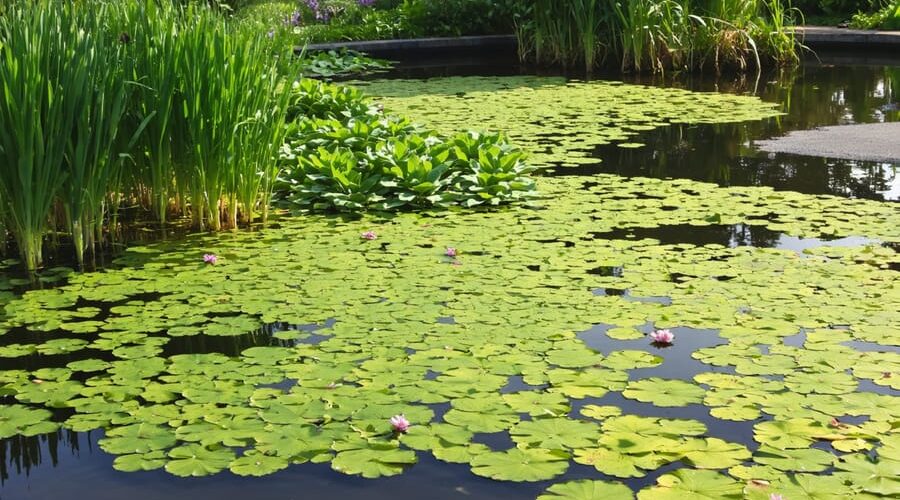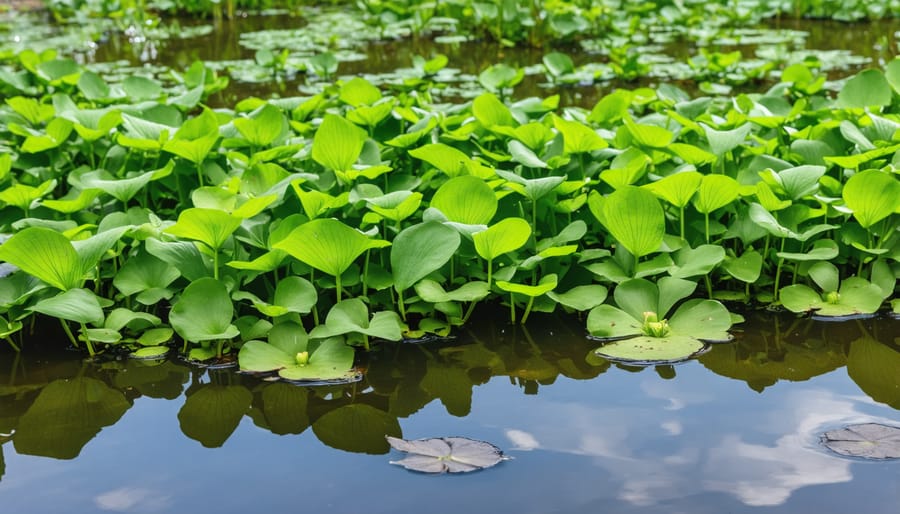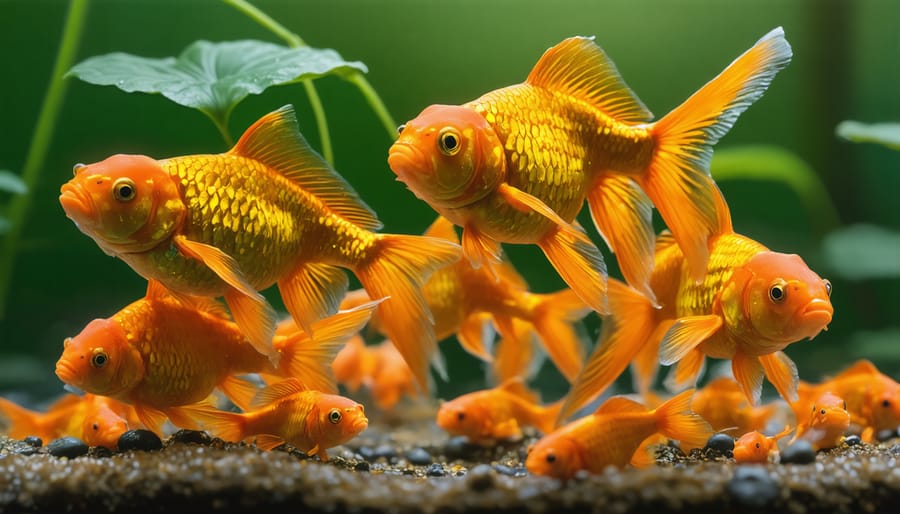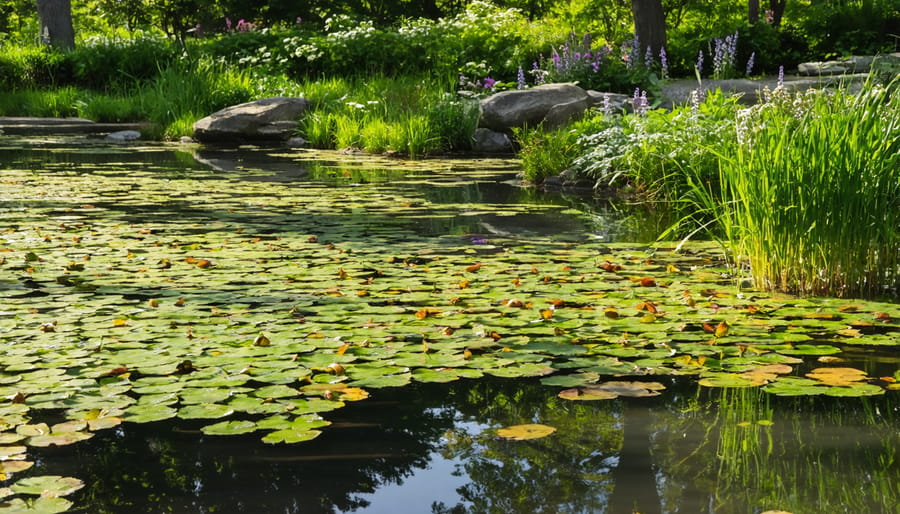
Protect Your Pond: How Invasive Species Can Destroy Your Water Garden
Inspect your pond weekly for unusual plant growth patterns, odd-colored algae, or unfamiliar floating vegetation – these are the earliest warning signs of invasive species taking hold. Install protective barriers around pond edges and filter all incoming water sources to protect your water garden from unwanted invaders. Remove any suspicious plants immediately, including their complete root systems, and dispose of them in sealed bags away from water sources. The impact of invasive species extends far beyond aesthetic concerns – these unwelcome guests can devastate native wildlife, alter water chemistry, and create long-lasting ecological damage that becomes increasingly difficult to reverse. As pond owners, we’re on the front lines of preventing these harmful species from spreading to our local waterways, making early detection and swift action essential tools in maintaining healthy aquatic ecosystems.
Common Invasive Species Threatening Water Gardens
Aggressive Aquatic Plants
Among the most troublesome aquatic invaders, water hyacinth and duckweed stand out for their aggressive growth patterns and devastating impacts on pond ecosystems. Water hyacinth, with its deceptively beautiful purple flowers, can double its population in just two weeks, forming thick mats that completely cover water surfaces. These dense clusters block sunlight, deplete oxygen levels, and make it nearly impossible for native plants and fish to survive.
Duckweed, though tiny in size, poses similar challenges. These small, floating plants can quickly blanket entire ponds, turning clear water into what appears to be a green carpet. While some duckweed is natural and beneficial, invasive varieties can grow out of control, especially in nutrient-rich waters. They reproduce rapidly through budding, and a single plant can lead to thousands within days.
Both these aggressive invaders often hitchhike their way into ponds through contaminated equipment or when introduced as ornamental plants. Once established, they can clog filtration systems, hamper recreational activities, and create stagnant conditions that mosquitoes love. The key to managing these plants lies in early detection and swift action. Regular monitoring, proper plant disposal, and maintaining balanced nutrient levels in your pond can help prevent these invasive species from taking hold and destroying your carefully cultivated water garden.

Problematic Fish Species
Several invasive fish species can wreak havoc in pond ecosystems, with some of the most troublesome being Common Carp, Grass Carp, and Koi. While Koi are beloved ornamental fish, escaped or deliberately released specimens can become invasive in natural waterways, competing with native species for food and space.
Common Carp are particularly destructive, as they uproot aquatic plants while feeding and increase water turbidity, making it difficult for other species to thrive. Their bottom-feeding behavior stirs up sediment, which can lead to poor water quality and algae blooms. These fish also reproduce rapidly, quickly overwhelming smaller water bodies.
Grass Carp, originally introduced for aquatic weed control, can completely eliminate vegetation from ponds when present in high numbers. While they can be effective for weed management when properly managed, unauthorized releases have led to significant environmental problems in many areas.
Other problematic species include Goldfish, which can grow surprisingly large in the wild and compete with native fish, and Mosquito Fish, which, despite being introduced to control mosquitoes, often prey on native fish eggs and small amphibians.
For pond owners, it’s crucial to choose fish species carefully and ensure they can’t escape into natural waterways. Always check local regulations before introducing any fish species, as some may be restricted or require special permits. If you spot invasive fish in your pond, contact your local wildlife authorities for guidance on proper removal methods.

Warning Signs Your Pond is Under Attack
Keeping a watchful eye on your pond is crucial for early detection of invasive species. As an experienced pond enthusiast, I’ve learned that catching these unwanted visitors early can save you time, money, and heartache. Here are the key warning signs of pond problems you should never ignore.
First, watch for sudden changes in water clarity. If your normally clear pond becomes cloudy or takes on an unusual color, especially a greenish or reddish tint, this could indicate invasive algae species taking hold. Keep an eye on your water plants too – if they’re being outcompeted or showing signs of stress, you might have an unwelcome guest in your pond.
Look out for these tell-tale signs:
– Rapid growth of unfamiliar plants or floating vegetation
– Native plants dying off unexpectedly
– Unusual movements or disturbances in the water
– New fish species you didn’t introduce
– Declining fish population or stressed fish behavior
– Unexplained damage to pond equipment or liner
– Strange odors coming from your pond
Your pond’s edges deserve special attention. Notice any new plants growing along the banks? Invasive species often start their takeover at the pond’s perimeter before spreading inward. Check regularly for unusual growth patterns or plants that seem to appear overnight.
Wildlife behavior can also tip you off. If local birds and animals suddenly avoid your pond, or if you notice a decrease in beneficial insects, something might be amiss. Even small changes in your pond’s ecosystem can signal bigger problems brewing beneath the surface.
Remember, the key to managing invasive species is catching them early. Make it a habit to inspect your pond weekly, and don’t hesitate to investigate anything that seems out of the ordinary. Your quick action could be the difference between a minor intervention and a major pond restoration project.

Preventing Invasive Species in Your Water Garden
Smart Plant Selection
Making smart plant choices is your first line of defense against invasive species in your water garden. Start by researching native plants that naturally thrive in your local area – they’re not just beautiful, but they’re also crucial for maintaining pond biodiversity and supporting local wildlife.
Before purchasing any new plants, check your regional invasive species list. Many beautiful but aggressive plants like Water Hyacinth and Yellow Flag Iris might be readily available but can quickly become a nightmare in your pond. Instead, opt for well-behaved alternatives like native Water Lilies, Rush, or Marsh Marigold.
When shopping, inspect plants carefully for hitchhikers. Look for snails, eggs, or unfamiliar insects that might be hiding in the soil or on leaves. Choose plants from reputable suppliers who can verify their species and origin. It’s worth paying a bit more for quality, disease-free specimens from knowledgeable sellers.
Consider the plant’s growth habit and space requirements. Fast-growing species might seem appealing for quick coverage, but they often become problematic. Choose plants that match your pond’s size and conditions. Remember, a well-planned selection of appropriate plants will create a more sustainable and enjoyable water garden while keeping invasive threats at bay.
Responsible Fish Stocking
When adding new fish to your pond, responsible stocking practices are essential to prevent invasive species from taking over. Always purchase fish from reputable suppliers who can verify their species and origin. Before introducing any new fish, quarantine them in a separate tank for at least two weeks to monitor for signs of disease or unexpected aggressive behavior.
Research your local regulations regarding permitted fish species, as these rules exist to protect native ecosystems. Some popular ornamental fish, like goldfish and koi, can become invasive if they escape into natural waterways. Install proper barriers and screens to prevent fish from being washed out during heavy rains or flooding.
Consider the size of your pond when stocking fish. A general rule of thumb is one inch of fish per ten gallons of water. Overstocking can lead to competition for resources and encourage fish to seek new territories, potentially spreading to natural water bodies.
Never release unwanted pond fish into local waterways, streams, or lakes. If you can no longer care for your fish, contact local aquarium societies, pet stores, or other pond owners who might adopt them. Some areas have specific fish surrender programs to prevent the release of non-native species into the environment.
Choose fish species that are well-suited to your climate and won’t outgrow your pond. This reduces the temptation to release overgrown fish into natural waters.
Natural Control Methods That Work
When it comes to managing invasive species, natural control methods offer effective solutions without harming your pond’s delicate ecosystem. One of the most successful approaches is introducing beneficial native species that naturally compete with or feed on invasive ones. For instance, adding native fish species like grass carp can help control unwanted aquatic plants, while beneficial insects can keep invasive insect populations in check.
Creating physical barriers is another eco-friendly strategy that works wonders. Installing fine mesh screens around pond edges prevents invasive plant fragments from spreading, while strategically placed barriers can block unwanted wildlife access. These simple solutions require minimal maintenance and provide long-term protection.
Maintaining optimal water conditions is crucial for natural invasive species control. Regular water testing and adjusting pH levels naturally discourages many invasive species from establishing themselves. Adding beneficial bacteria helps break down excess nutrients that invasive plants typically thrive on, making your pond less hospitable to unwanted guests.
Hand removal, while labor-intensive, remains one of the most effective natural control techniques. Regular monitoring and prompt removal of invasive plants or animals before they establish themselves can prevent larger infestations. Remember to dispose of removed species properly to prevent their spread to other water bodies.
Consider creating a diverse habitat that supports native species. Plant native aquatic plants around your pond’s edges and maintain different depth zones. This natural diversity makes it harder for invasive species to gain a foothold. Plus, a healthy ecosystem of native plants and animals naturally resists invasion through competition for resources.
You can also use natural plant-based deterrents. Some native plants release natural compounds that discourage invasive species growth. For example, barley straw has been traditionally used to inhibit algae growth, while certain aromatic plants can deter unwanted insects and animals.
Remember, patience is key with natural control methods. While they may take longer to show results compared to chemical alternatives, they provide sustainable, long-term solutions that protect your pond’s ecosystem and all the creatures that call it home.
The impact of invasive species on our water gardens and natural ecosystems cannot be overstated. By staying vigilant and implementing preventive measures, we can protect our beloved ponds while contributing to the broader environmental conservation effort. Remember to regularly inspect your plants, avoid introducing unknown species, and maintain proper quarantine procedures for new additions. Early detection and swift action are your best allies in keeping invasive species at bay. While it may seem like extra work, the time and effort invested in prevention are far less costly than dealing with an established invasion. Together, we can create and maintain beautiful, thriving water gardens that support, rather than harm, our local ecosystems. Keep learning, stay observant, and don’t hesitate to reach out to local experts when in doubt.
